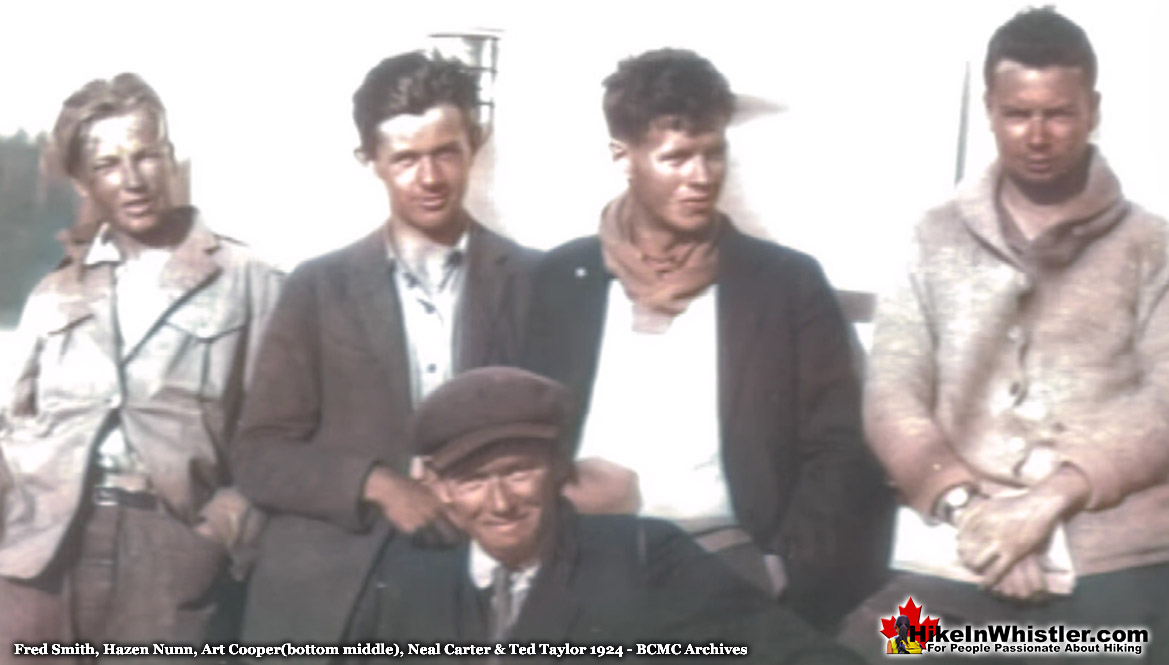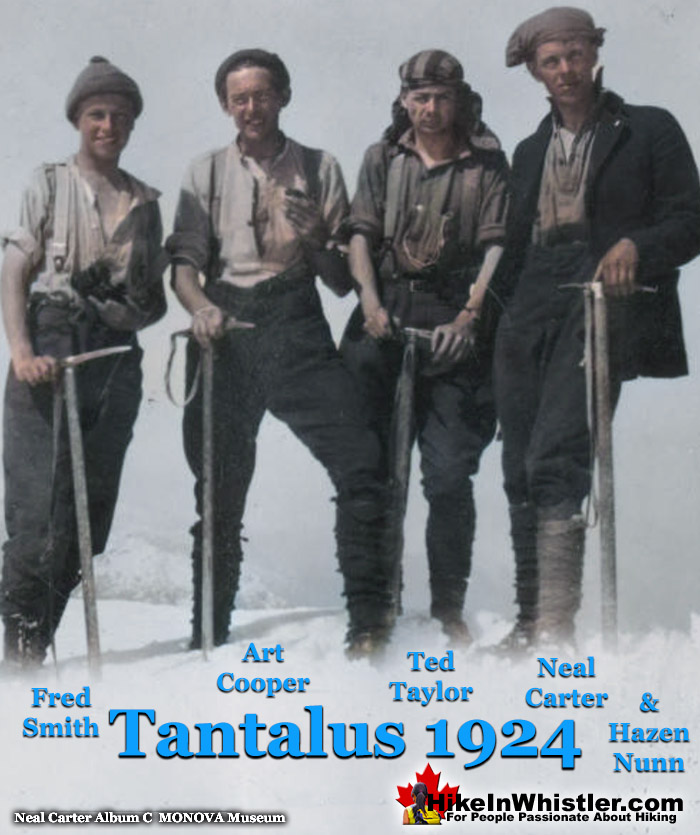
![]() In the spring of 1924 Neal Carter set out on his second expedition into the Tantalus Range with Hazen Nunn, Ted Taylor, Arthur Cooper and Fred Smith. Mount Tantalus was their main goal, however, deep springtime snow, bad weather and difficult route finding barred their attempt. Despite not reaching the summit of Tantalus, the expedition reached the summits of several other prominent mountain peaks, such as Alpha, Pelops, Dione and Omega.
In the spring of 1924 Neal Carter set out on his second expedition into the Tantalus Range with Hazen Nunn, Ted Taylor, Arthur Cooper and Fred Smith. Mount Tantalus was their main goal, however, deep springtime snow, bad weather and difficult route finding barred their attempt. Despite not reaching the summit of Tantalus, the expedition reached the summits of several other prominent mountain peaks, such as Alpha, Pelops, Dione and Omega.
Neal Carter Mountaineer
- Neal Carter Mountaineering Highlights
- First Ascents by Neal Carter
- 1920: Black Tusk North Pinnacle
- 1922: Second Ascent of The Table
- 1923: Carter/Townsend Expedition
- 1932: Mount Meager Expedition
- 1933: To the Cradle of Toba River!
- 1934: Mount Waddington Tragedy
Along the way they named several unnamed mountains in keeping with the Greek myth of Tantalus. Niobe, Pelops, Dione, Sisyphus and Pandareus are all names created by Neal Carter, Hazen Nunn, Ted Taylor, Art Cooper and Fred Smith in 1924. Carter's beautiful photo album of the expedition is now at the MONOVA Museum in Vancouver. Hazen Nunn wrote about the 1924 Tantalus expedition in the BC Mountaineer in June of that year. His detailed account along with Carter’s photo album recall this fascinating expedition into the Tantalus Range. The following is Hazen Nunn’s article with images and captions from Neal Carter’s photo album added. Most of the photos have been partly colorized to try to bring the original black and white images more to life. Date headings have also been added to Nunn's article.
BC Mountaineer No.4, Vol. 2 JUNE, 1924
CLIMBING IN THE TANTALUS RANGE
By E. H. Nunn
Saturday, May 10th, 1924
Our party, consisting of Neal Carter, Ted Taylor, Arthur Cooper, Fred Smith, and myself, left on May 10 for Squamish to spend a week in the Tantalus Range. Leaving the boat, we learned that Barber's Camp on the Squamish River was not operating, so had to abandon the idea of camping at 5,000 feet and proposed to make camp instead at Tantalus Lake or the “Lake of Lovely Waters”, at 3,700 feet. We got to Chee Kye at 4.30 and a hike of about two miles brought us to the Squamish River where we made our first night’s camp. The beauty of a perfect moonlight night was somewhat marred by armies of husky mosquitoes who attacked us on all sides, and we retired early to our sleeping bags,--two to a bag, the advantage being of less weight to pack and of added warmth, although the prominent features of one’s anatomy are somewhat accentuated.
Sunday, May 11th, 1924: Hike to "Lake of the Lovely Waters"
At 5:30 am we beheld the sun rising over Garibaldi, and to the west our Tantalus peaks swimming in a sea of molten gold. Hurriedly eating our breakfast, we cached some grub and crossed the river by the cable near our camp.
Squamish River Cable Car Crossing - 11 May 1924
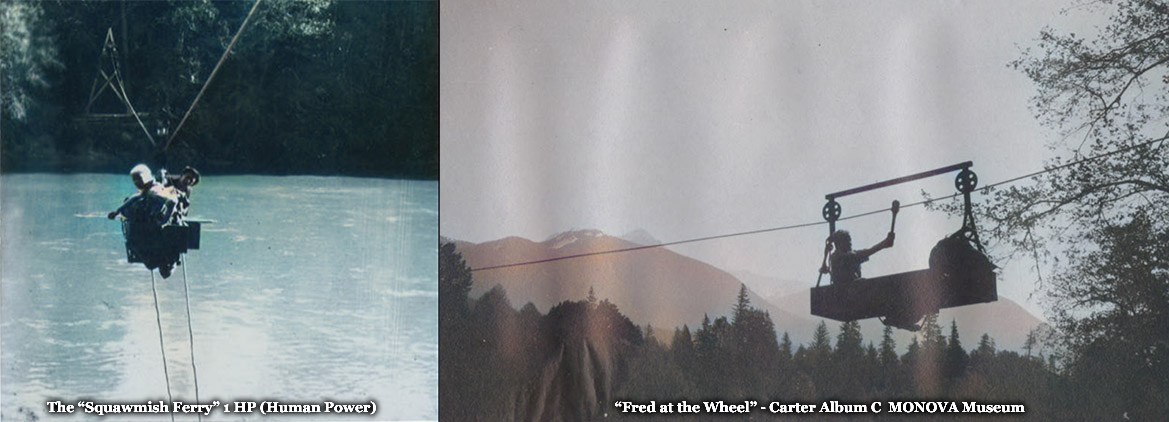
From here we lunged into virgin forest and pushed our way through underbrush and over fallen timber until, at 12:30, we emerged at the creek which drains the lake. We were now only at 1,000 feet, but from this point on, the going became better. Ascending a rock-slide for 1,000 feet, we hit the snow line (3,100) at 4:30. Here the going became better still and we were soon on the ridge in view of the lake. Finding no bare ground, camp was made on the snow. We retired early in anticipation of a good day’s climbing on the morrow.
"Lake of the Lovely Waters" Camp - 11 May 1924
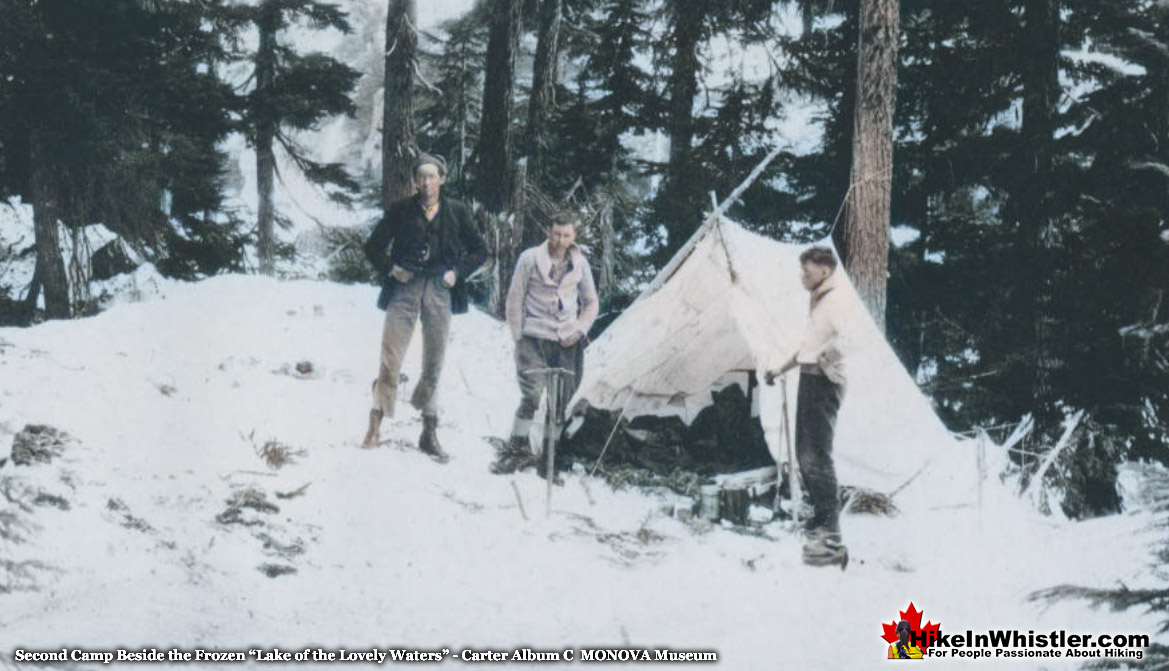
Monday, May 12th, 1924: Mt. Alpha
Leaving camp at 8:30 Monday a.m. we hiked down the frozen lake to a favourable point and commenced the assault on Mt. Alpha. A few preliminary snow slopes brought us to the scree-covered ledges of the main peak. To the west lay the serrated crags and pinnacles of the Red Tusk Ridge, dominated by Mt. Serratus itself. From this ridge a series of glaciers flow eastward toward the lake, each terminating in an ice-fall, from which came almost a continuous roar as tons of rock and snow poured over the cliffs.
Alternating between interesting rock work and steep snow slopes, we passed the last vestige of vegetation at 11:30 (6,400). At this point we were surprised by an avalanche which swept down the slopes not twenty feet from us and went thundering down over the cliff. The rock ledges were covered with a lot of loose rocks, and the rear climbers were kept busy dodging the fusillade. Suffering no casualties, we arrived on the corniced summit at 1:50 and found in the cairn a record to the effect that A.B. Morkill and B.S. Darling had made the first ascent in 1914, and that Tom and John Fyles had climbed the peak in 1916. Ours was the third ascent and the earliest. Observations on two aneroids gave and elevation of about 7,700 feet. Lunch and the wonderful view were absorbed simultaneously and made a good combination. To the east lay the Garibaldi group, with the cairn on The Table visible with the naked eye. With the aid of our field glasses, though, some of the more obscure details were easily recognized. To the north we could see Wedge Mt, and Mt. Turner. Behind us, to the south, lay the local peaks with Mts. Crown, Bishop, Cathedral and Brunswick plainly visible—the Sawteeth also showing up well. To the southwest reared the imposing massif of Mt. Sir Roderick, and in the further distance rose the Jervis Inlet peaks. On every hand stretched an endless ocean of snowy pinnacles and billowy ridges,—material to reward the efforts of exploration for many years to come. In the valley, 7,500 feet below us, lay the thread-like Squamish River, and the tiny villages of Chee Kye and Brackendale.
"Our First Climb" Mt. Alpha - 12 May 1924
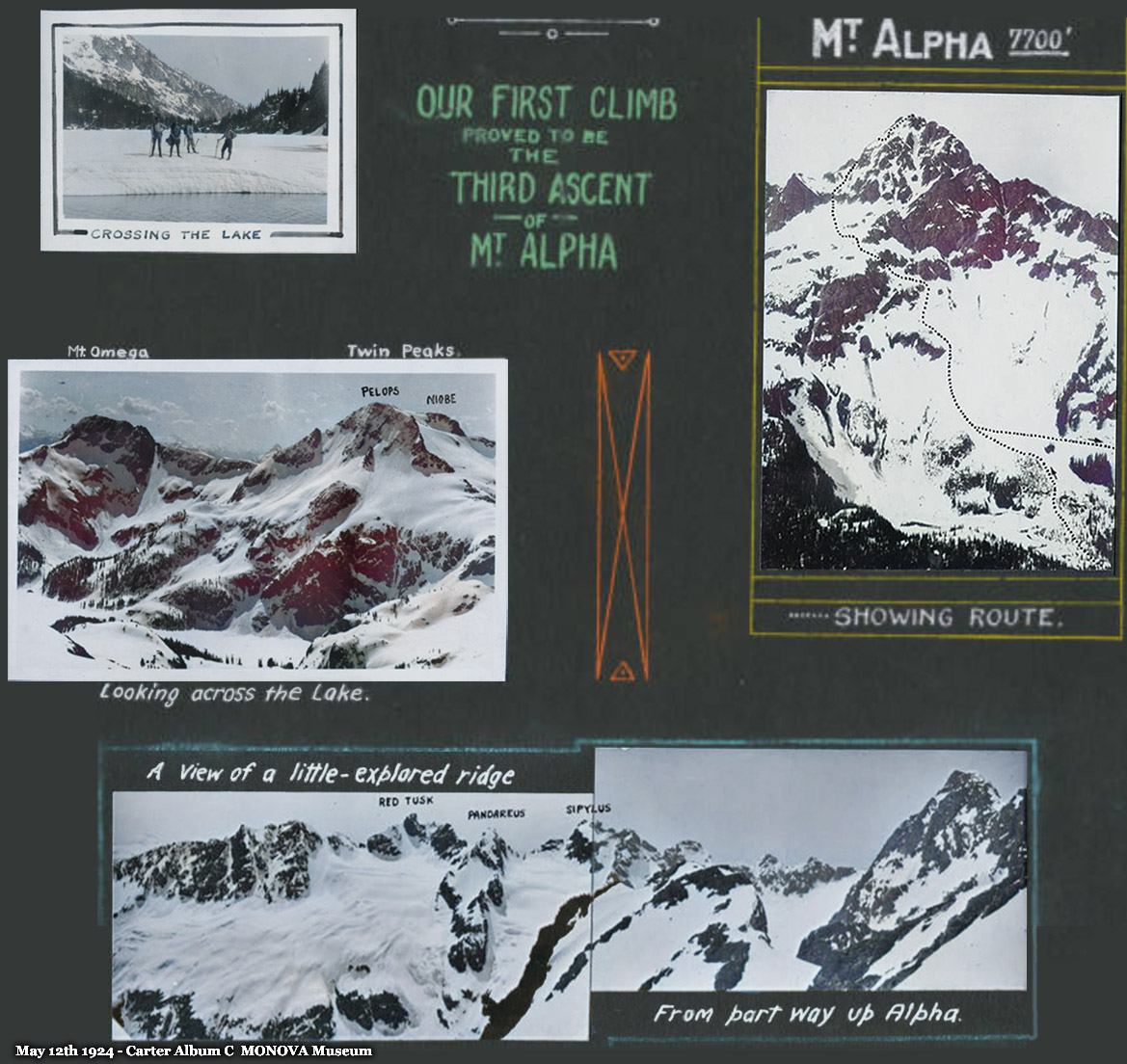
Tantalus Range Peaks Named
Mts. Alpha and Omega (also known as the South Peak), are visible from the Squamish Valley and are well known by name. We suggested a number of new names from the Greek myth of Tantalus. Thus the N. and S, Twin Peaks we called Niobe and Pelops, while the two main peaks of the range we named Tantalus and Dione. Two prominent pinnacles in the Red Tusk Ridge we called Sisyphus and Pandareus.
Mt. Alpha Summit - 12 May 1924
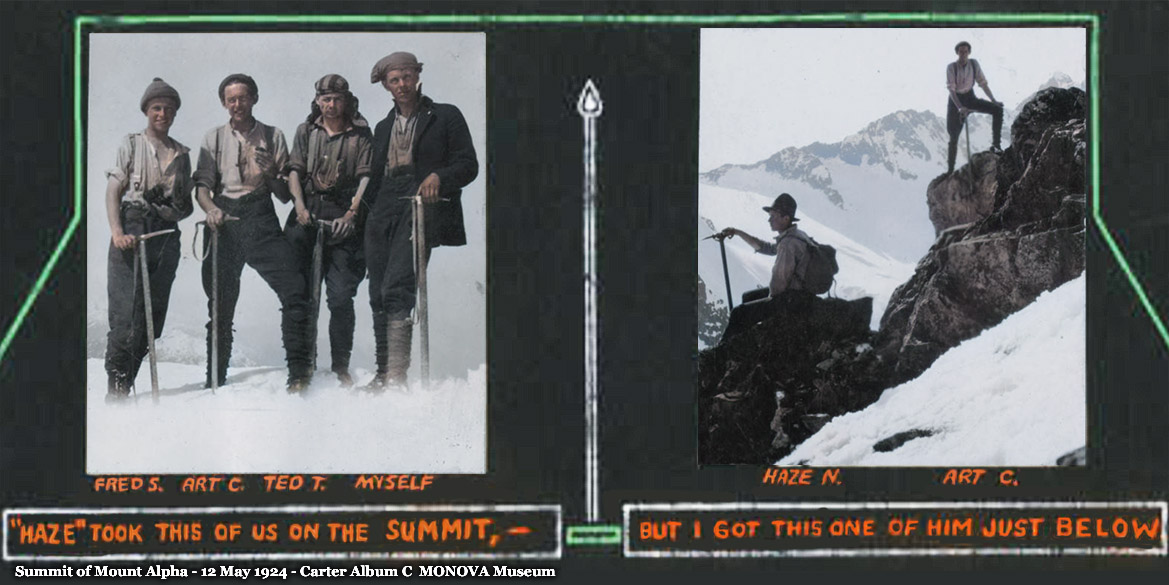
Panorama From Mt. Alpha - 12 May 1924

Fred Smith, Ted Taylor & Arthur Cooper Mt. Alpha - 12 May 1924
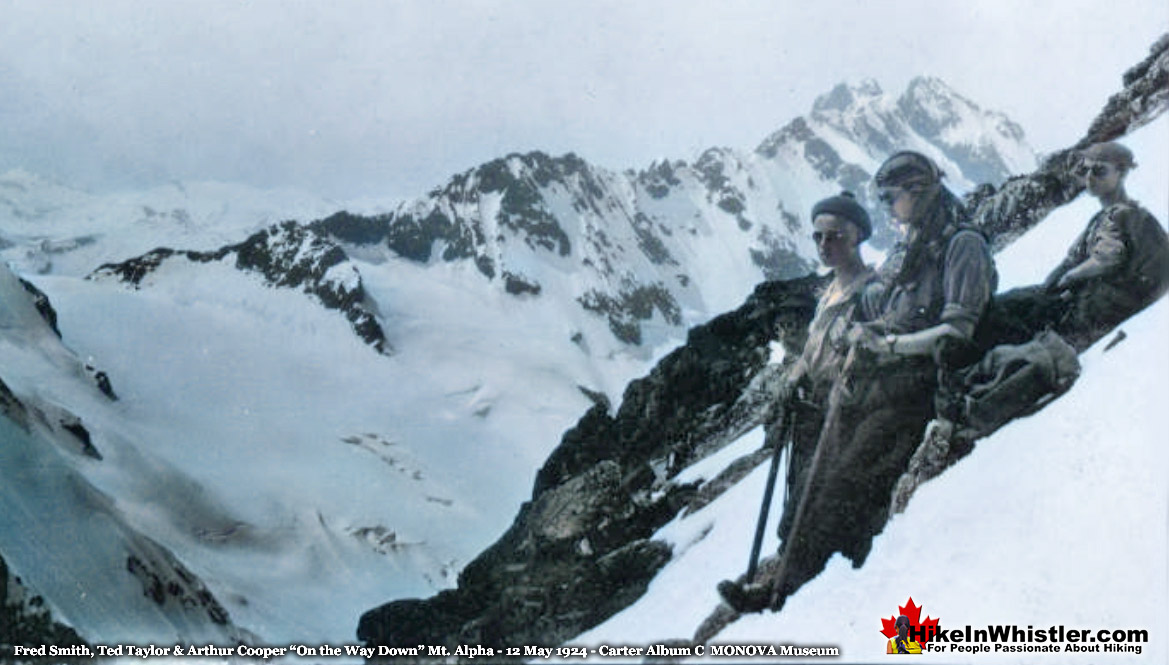
At 3.30, having taken some plane-table observations for a map of the district, we left the summit, and after an exhilarating descent arrived on the lake at sunset. In this vicinity we noticed several areas of red snow. The lake was a bit slushy, and every step was a knee-deep plunge. We arrived back in camp at 6.25, and a victorious attack was made on the macaroni and cheese.
Tuesday, May 13th, 1924: View Rock, Pelops & Niobe
Tuesday morning, we left at 9.15 and crossed the lake towards the southern peaks. Ascending a snow gully, we emerged into a glacial amphitheatre filled with avalanched debris. From here an hours grind up the north margin of the snow covered glacier brought us to the neve. In places the wind had blown the snow away, exposing the blue and green ice. In front of us rose the Twin peaks,—Pelops and Niobe; behind us towered Omega, and to the north loomed the imposing mass of Alpha. On our left we noticed a small, but promising looking, rocky peak. (View Rock, now officially named Mt. Iota).
Route Up Pelops and Niobe - 13 May 1924
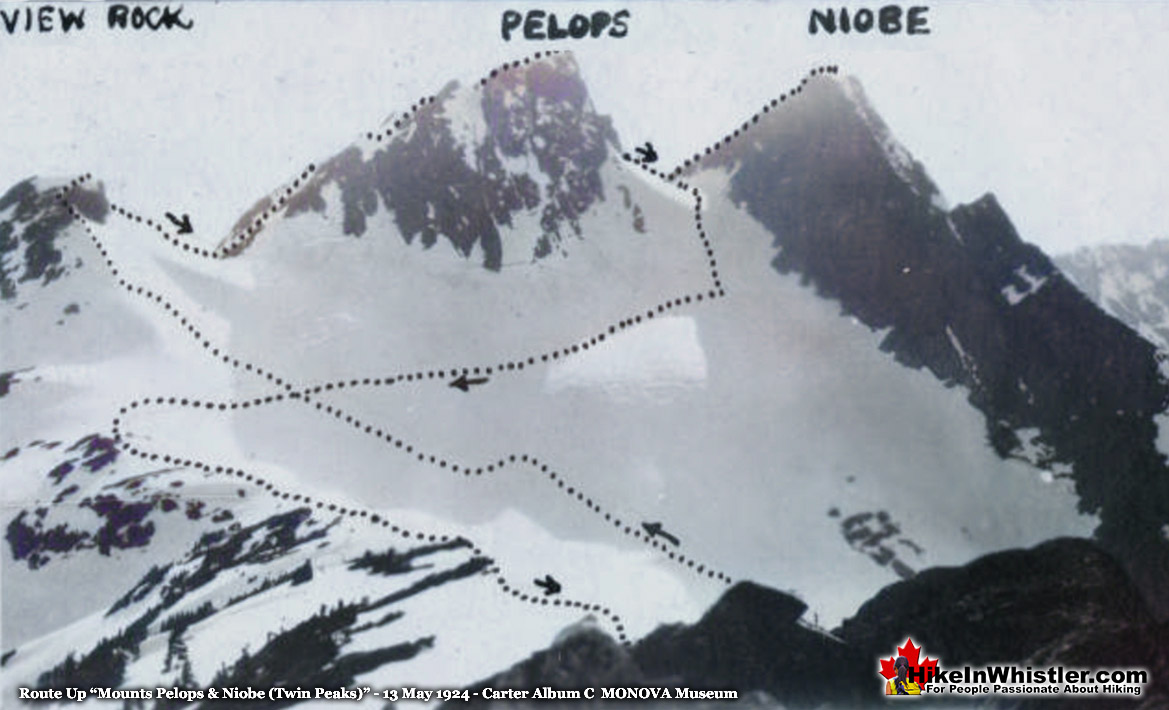
View Rock (Mt. Iota) Summit
By noon we had gained the summit and found that Smith and Warren had made the first ascent in 1910. Mt. Sir Roderick looked very impressive from this point and we could also see that the route in to the Tantalus district by Mill Creek would be impracticable as two ridges of about 5,500 feet altitude would have to be crossed and the deep intervening valley would make packing in difficult.
"The Three Musketeers on the Rock" (Mt. Iota) - 13 May 1924

Mount Pelops Summit
Dropping down again to the neve, we ascended Mt. Pelops by a series of snow slopes broken by jutting rock ridges. Finding no cairn on the summit we left evidence of the first recorded ascent, and observed the elevation to be about 6,800 feet, and that of Mt. Dione Mt. Niobe (Nunn incorrectly wrote Mt. Dione instead of Mt. Niobe) to be slightly lower. On the ridge between the two Twin peaks we found a fine example of a wind cirque which showed the depth of snow to be about 40 feet.
"A Tremendous Wind-Sweep Between Pelops and Niobe" - 13 May 1924
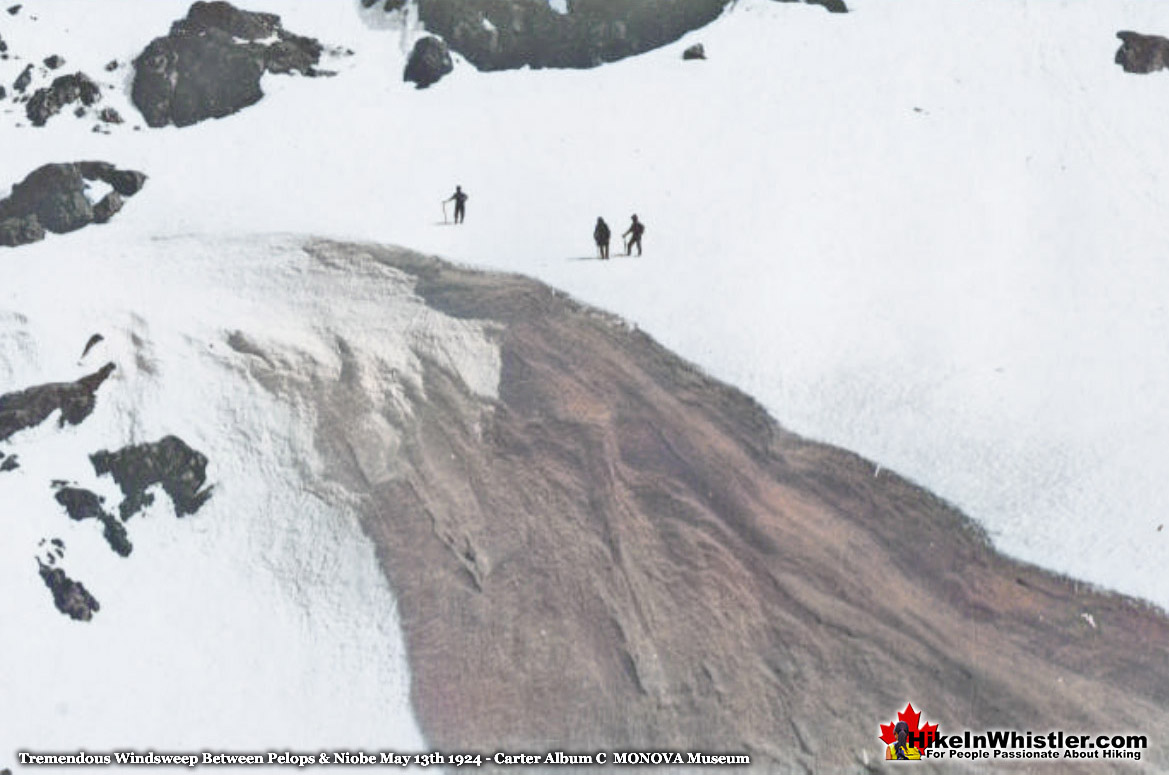
Mount Niobe Summit
By 2:40 we were on Mt. Dione Mt. Niobe (Nunn incorrectly wrote Mt. Dione, they were on Mt. Niobe) and found a record stating that Smith and Warren had climbed the peak in 1910.
Mount Omega Summit
Leaving at 3.15, we glissaded down to the neve and, traversing below the cliffs of Pelops, crossed the snowfield towards Mt. Omega. An interesting rock scramble brought us to the summit at 5.15. There was a cairn with no record, but we recently learned that it had been built by Tom Fyles in 1916.
"Mt. Omega from the Rock" (Mt. Iota) - 13 May 1924
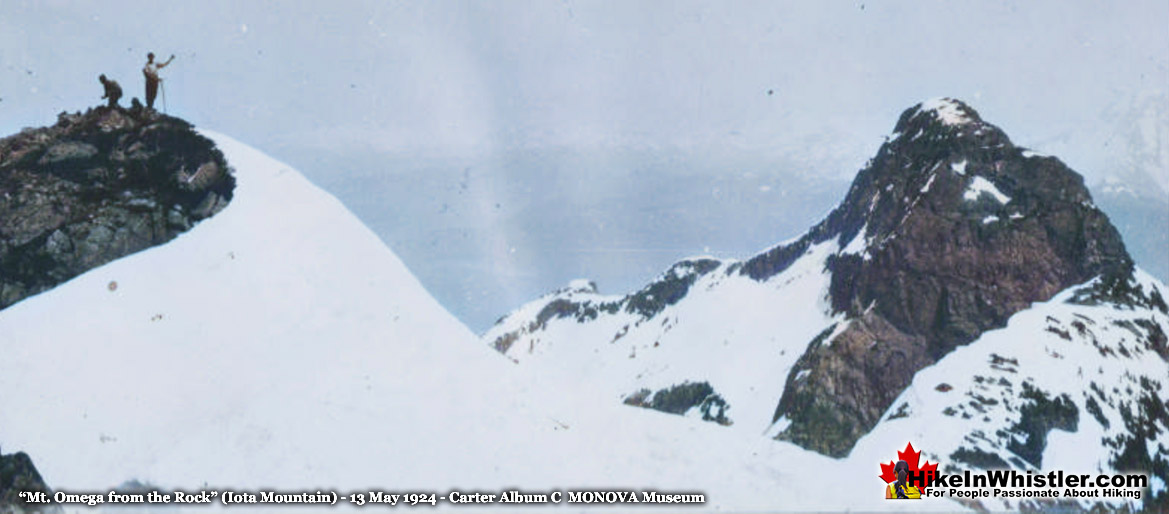
The view from the peak was almost as fine as from Alpha. The sun was getting low and the peaks threw their shadows for miles across the snowfields and glaciers. The bases of the crags and their ridges lay in the soft purple shadows of twilight, but the summits still flamed with the fiery splendor of the sunset. The tremendous ice-fall of the Chee Kye glacier on the west face of Garibaldi looked especially fine where the level rays of the sun brought out the vivid blue and green in the ice, contrasting with the red volcanic rock. We left Omega at 5.45, and after scrambling down the rocks, glissaded back into the amphitheatre. From here a short hike across, or more properly, through, the lake brought us back to camp.
Wednesday, May 14th, 1924
Wednesday dawned cold and cloudy, so we stayed in the vicinity of the camp all day.
Thursday, May 15th, 1924
Thursday was another dull day so we broke camp quite early and left the Lake of Lovely Waters at about 10. Following our route in over the rock-slide we arrived at the creek at 1.45 and found the water much higher. We finally managed to cross, however, and followed the ridge down to the Squamish River. A hike of about two miles along the west bank landed us back at the cable and we were not delighted to find the car on the wrong side. The situation was saved, however, by Neal, who made a rope sling and hauled himself across, At 7.30 we hit the Cheakamus River and made camp.
Friday, May 16th, 1924
Leaving Chee Kye at 9.30 a.m. Friday we started the ten-mile hike to Squamish, but fortunately got a lift for six miles. An enjoyable trip down the Sound landed us in the city at 5.30.
Fred Smith, Hazen Nunn, Art Cooper, Neal Carter & Ted Taylor
